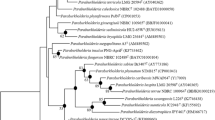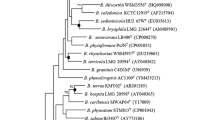Abstract
A novel bacterium, designated DCY112T, was isolated from the rhizospheric soil of a ginseng-cultivated field in Gochang-gun, Republic of Korea. Based on 16S rRNA gene sequence analysis, this isolate was assigned to the genus Rhodanobacter and is closely related to Rhodanobacter soli DCY45T (98.0%) and R. umsongensis GR24-2T (98.0%). Strain DCY112T is Gram-negative, catalase- and oxidase-positive, aerobic, non-motile, rod-shaped, and produces yellow-pigmented colonies on R2A medium. Q-8 was the predominant respiratory quinone. The major cellular fatty acids were iso-C15:0, iso-C17:0, and summed feature 9 (iso-C17:1 ω9c and/or 10-methyl-C16:0). The major polar lipids were phosphatidylglycerol (PG), phosphatidylethanolamine (PE), an unknown amino lipid (AL1), and an unidentified polar lipid (L3). The genomic DNA G + C content was 65.2 mol%. DNA–DNA homology values between strain DCY112T and related strains were lower than 55%. The low DNA relatedness data in combination with phenotypic and genotypic tests indicated that strain DCY112T could not be assigned to a recognized species. Strain DCY112T showed antagonistic activity against the fungal pathogen Fusarium solani (KACC 44891T), which causes ginseng root rot. The results of this study support that strain DCY112T is a novel species belonging to the genus Rhodanobacter, for which the name Rhodanobacter ginsengiterrae is proposed. The type strain is DCY112T (= KCTC 62018T = JCM 32167T).

Similar content being viewed by others
References
An DS, Lee HG, Lee ST, Im WT (2009) Rhodanobacter ginsenosidimutans sp. nov., isolated from soil of a ginseng field in South Korea. Int J Syst Evol Microbiol 59:691–694
Bauer A, Kirby W, Sherris JC, Turck M (1966) Antibiotic susceptibility testing by a standardized single disk method. Am J Clin Pathol 45:493–496
Bernardet JF, Nakagawa Y, Holmes B (2002) Proposed minimal standards for describing new taxa of the family Flavobacteriaceae and emended description of the family. Int J Syst Evol Microbiol 52:1049–1070
Bloemberg GV, Lugtenberg BJJ (2001) Molecular basis of plant growth promotion and biocontrol by rhizobacteria. Curr Opin Plant Biol 4:343–350
Bui TPN, Kim YJ, Kim H, Yang DC (2010) Rhodanobacter soli sp. nov., isolated from soil of a ginseng field. Int J Syst Evol Microbiol 60:2935–2939
Cappuccino JG, Sherman N (2002) Microbiology, a laboratory manual, 6th edn. Pearson Education, Inc., London
Cho GY, Lee JC, Whang KS (2017) Rhodanobacter rhizosphaerae sp. nov., isolated from soil of ginseng rhizosphere. Int J Syst Evol Microbiol 67:1387–1392
De Clercq D, Van Trappen S, Cleenwerck I, Ceustermans A, Swings J, Coosemans J, Ryckeboer J (2006) Rhodanobacter spathiphylli sp. nov., a gammaproteobacterium isolated from the roots of Spathiphyllum plants grown in a compost-amended potting mix. Int J Syst Evol Microbiol 56:1755–1759
Ezaki T, Hashimoto Y, Yabuuchi E (1989) Fluorometric deoxyribonucleic acid-deoxyribonucleic acid hybridization in microdilution wells as an alternative to membrane filter hybridization in which radioisotopes are used to determine genetic relatedness among bacterial strains. Int J Syst Evol Microbiol 39:224–229
Farh ME-A, Kim YJ, Van An H, Sukweenadhi J, Singh P, Huq MA, Yang DC (2015) Burkholderia ginsengiterrae sp. nov. and Burkholderia panaciterrae sp. nov., antagonistic bacteria against root rot pathogen Cylindrocarpon destructans, isolated from ginseng soil. Arch Microbiol 197:439–447
Felsenstein J (1981) Evolutionary trees from DNA sequences: a maximum likelihood approach. J Mol Evol 17:368–376
Felsenstein J (1985) Confidence limits on phylogenies: an approach using the bootstrap. Evolution 39:783–791
Fitch WM (1971) Toward defining the course of evolution: minimum change for a specific tree topology. Syst Biol 20:406–416
Hall TA (1999) BioEdit: a user-friendly biological sequence alignment editor and analysis program for Windows 95/98/NT. Nucleic Acids Symp Ser 41:95–98
Hiraishi A, Ueda Y, Ishihara J, Mori T (1996) Comparative lipoquinone analysis of influent sewage and activated sludge by high-performance liquid chromatography and photodiode array detection. J Gen Appl Microbiol 42:457–469
Im WT, Lee ST, Yokota A (2004) Rhodanobacter fulvus sp. nov., a beta-galactosidase-producing gammaproteobacterium. J Gen Appl Microbiol 50:143–147
Jung HM, Ten LN, Kim KH, An DS, Im WT, Lee ST (2009) Dyella ginsengisoli sp. nov., isolated from soil of a ginseng field in South Korea. Int J Syst Evol Microbiol 59:460–465
Kang JP, Nguyen NL, Kim YJ, Hoang VA, Bae KS, Yang DC (2015) Paralcaligenes ginsengisoli sp. nov., isolated from ginseng cultivated soil. Antonie Van Leeuwenhoek 108:619–626
Kim YS, Kim SJ, Anandham R, Weon HY, Kwon SW (2013) Rhodanobacter umsongensis sp. nov., isolated from a Korean ginseng field. J Microbiol 51:258–261
Lane D (1991) 16S/23S rRNA sequencing. In: Stackebrandt E, Goodfellow M (eds) Nucleic acid techniques in bacterial systematics. Wiley, Chichester, pp 115–176
Lee CS, Kim KK, Aslam Z, Lee ST (2007) Rhodanobacter thiooxydans sp. nov., isolated from a biofilm on sulfur particles used in an autotrophic denitrification process. Int J Syst Evol Microbiol 57:1775–1779
Levine M, Epstein S, Vaughn R (1934) Differential reactions in the colon group of bacteria. Am J Public Health Nations Health 24:505–510
Mesbah M, Premachandran U, Whitman WB (1989) Precise measurement of the G + C content of deoxyribonucleic acid by high-performance liquid chromatography. Int J Syst Evol Microbiol 39:159–167
Mesbah NM, Whitman WB, Mesbah M (2011) Determination of the G + C content of prokaryotes. Methods Microbiol 38:299–324
Minnikin D, O’donnell A, Goodfellow M, Alderson G, Athalye M, Schaal A, Parlett J (1984) An integrated procedure for the extraction of bacterial isoprenoid quinones and polar lipids. J Microbiol Methods 2:233–241
Nalin R, Simonet P, Vogel TM, Normand P (1999) Rhodanobacter lindaniclasticus gen. nov., sp. nov., a lindane-degrading bacterium. Int J Syst Evol Microbiol 49(1):19–23
Prakash O, Green SJ, Jasrotia P et al (2012) Rhodanobacter denitrificans sp. nov., isolated from nitrate-rich zones of a contaminated aquifer. Int J Syst Evol Microbiol 62:2457–2462
Saitou N, Nei M (1987) The neighbor-joining method: a new method for reconstructing phylogenetic trees. Mol Biol Evol 4:406–425
Sasser M (1990) Identification of bacteria by gas chromatography of cellular fatty acids. MIDI technical note 101. MIDI Inc, Newark
Tamura K, Stecher G, Peterson D, Filipski A, Kumar S (2013) MEGA6: molecular evolutionary genetics analysis version 6.0. Mol Biol Evol 30:2725–2729
Thompson JD, Gibson TJ, Plewniak F, Jeanmougin F, Higgins DG (1997) The CLUSTAL_X windows interface: flexible strategies for multiple sequence alignment aided by quality analysis tools. Nucleic Acids Res 25:4876–4882
Wang L, An DS, Kim SG, Jin FX, Lee ST, Im WT (2011) Rhodanobacter panaciterrae sp. nov., a bacterium with ginsenoside-converting activity isolated from soil of a ginseng field. Int J Syst Evol Microbiol 61:3028–3032
Weisburg WG, Barns SM, Pelletier DA, Lane DJ (1991) 16S ribosomal DNA amplification for phylogenetic study. J Bacteriol 173:697–703
Weon HY, Kim BY, Hong SB, Jeon YA, Kwon SW, Go SJ, Koo BS (2007) Rhodanobacter ginsengisoli sp. nov. and Rhodanobacter terrae sp. nov., isolated from soil cultivated with Korean ginseng. Int J Syst Evol Microbiol 57:2810–2813
Weon HY, Anandham R, Kim BY, Hong SB, Jeon YA, Kwon SW (2009) Dyella soli sp. nov. and Dyella terrae sp. nov., isolated from soil. Int J Syst Evol Microbiol 59:1685–1690
Won K, Singh H, Ngo HTT, Son H, Kook M, Kim KY, Yi TH (2015) Rhodanobacter koreensis sp. nov., a bacterium isolated from tomato rhizosphere. Int J Syst Evol Microbiol 65:1180–1185
Woo SG, Srinivasan S, Kim MK, Lee M (2012) Rhodanobacter caeni sp. nov., isolated from sludge from a sewage disposal plant. Int J Syst Evol Microbiol 62:2815–2821
Yang J, Kloepper JW, Ryu CM (2009) Rhizosphere bacteria help plants tolerate abiotic stress. Trends Plant Sci 14:1–4
Acknowledgements
This study was supported by a grant from the Korea Institute of Planning and Evaluation for Technology in Food, Agriculture, Forestry, and Fisheries (KIPET No. 317007-3), Republic of Korea.
Author information
Authors and Affiliations
Corresponding author
Ethics declarations
Conflict of interest
The authors declare that they have no conflict of interest.
Additional information
Communicated by Erko Stackebrandt.
The NCBI GenBank Accession Number for the 16S rRNA gene sequence of strain DCY112T is KY694397.
Digital Protologue Database (DPD) Taxon Number TA00434.
Electronic supplementary material
Below is the link to the electronic supplementary material.
Rights and permissions
About this article
Cite this article
Huo, Y., Kang, JP., Park, JK. et al. Rhodanobacter ginsengiterrae sp. nov., an antagonistic bacterium against root rot fungal pathogen Fusarium solani, isolated from ginseng rhizospheric soil. Arch Microbiol 200, 1457–1463 (2018). https://doi.org/10.1007/s00203-018-1560-9
Received:
Revised:
Accepted:
Published:
Issue Date:
DOI: https://doi.org/10.1007/s00203-018-1560-9




